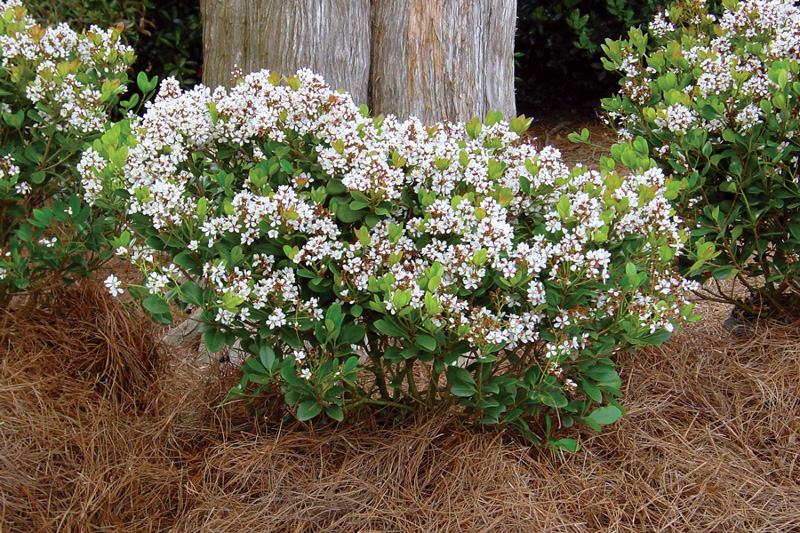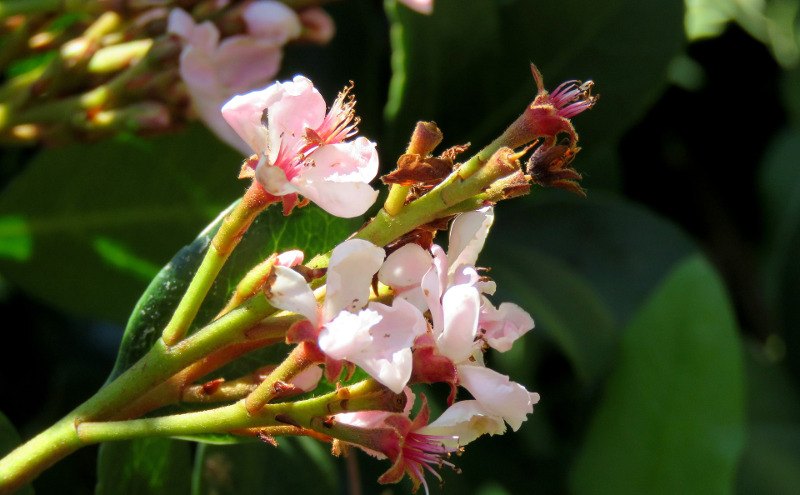Indian hawthorn (Rhaphiolepis indica) is an evergreen shrub in the family Rosaceae. This small shrub is native to China, growing in other parts of Asia and Australia as well. This plant can grow from 3 to 6 feet tall and wide with a mounded growth habit. Indian Hawthorne prefers well drained soil and an area that receives full sunlight to partial shade.
Hardy in USDA zones 7-11, this evergreen bush offers pretty pink or white flowers, berries and foliage that offers winter interest. Use Indian Hawthorn on your property in mass plantings, hedges, borders, and in garden planters.

Planting Indian Hawthorn Shrubs
This shrub has a fairly slow growth habit and is best planted in early spring time. Indian Hawthorne likes full sun but can tolerate some shade. Typically growing 3-6 feet tall and wide, space each shrub 18-24 inches apart. Not particularly picky about soil type, make sure that the soil is well draining. Water well after planting. Mulch around each shrub to help insulate and retain moisture.
Watering Indian Hawthorn Shrubs
A newly planted shrub will need evenly moist soil until the plant is well established. This young plant prefers moist but not soggy soil. Established Indian Hawthorn shrubs have some tolerance for drought. It is better to water this shrub with a good soaking of water when the soil is dry rather than the frequent quick watering. Wilting of the stems and leaves is a signal that the shrub needs a drink. Water at the base of the plant, avoiding the foliage.

Fertilizing Indian Hawthorn Shrubs
Indian Hawthorn shrubs are light feeders and do not require regular fertilization. This shrub will benefit from a spring time feeding to support new emerging growth. An application of all purpose slow-release fertilizer will encourage dark green foliage. Another option is to mix compost into the soil. Water well after any application of fertilizer.
Pruning Indian Hawthorn Shrubs
Indian Hawthorn shrubs grow in a naturally mounding habit and usually do not need routine pruning. You can lightly prune to remove any damaged, diseased or dead stems throughout the growing season. If you choose to drastically cut the shrub, do this just after the spring bloom cycle. Do not prune two months prior to the first frost as this can encourage new growth that may be damaged from cold temperatures.
Caring For Indian Hawthorn Shrubs in Pots
Indian Hawthorn shrubs are beautiful as a container plant. Select a container with good drainage holes and one that will allow for 2-3 years of growth. This shrub likes moist but well-drained soil. Choose a good quality potting soil and mix with perlite to support good drainage as consistently soggy soil can cause diseases. Place the container in a location that will get full sun to partial shade. Water well each time and allow the soil to completely dry out before watering again.
Winter Care for Indian Hawthorn Shrubs
Indian Hawthorn shrubs are an evergreen plant which means that the dark green foliage will remain on the branches all winter long. Hardy in USDA zones 8-11, during extremely cold spells, some precautions need to be taken. Do not fertilize in the fall as new growth can be damaged with cold temperatures. Water well in the fall and cover the base with mulch to preserve moisture and conserve heat. Do not prune what seems to be dead stems until the spring. These stems may bounce back in the spring and produce new foliage.
Indian Hawthorn Shrubs For Sale
Common Indian Hawthorn Care Questions
Why Are My Indian Hawthorn Shrubs Dying?
If your leaves and flowers are wilted and/or have lesions that are weepy, it could be fire blight, a disease to which Indian hawthorn are susceptible. It is prevalent in warm (75-85 degrees) humid or rainy areas. Remove the affected limbs and branches, making sure to cut them all the way back to where the wood is healthy. Leaf spot is also a problem common to the plant and can be remedied by making sure your plants have adequate air circulation and making sure to water them from the bottom, near the base, without getting the plant itself wet.
What Is The Growth Rate For Indian Hawthorn?
As is always the case with growth rates of plants, it is affected by soil quality, watering, weather, etc. but generally, the Indian hawthorns have a growth rate of around a foot, annually.
What Are The Indian Hawthorn Diseases?
If your leaves and flowers are wilted and/or have lesions that are weepy, it could be fire blight, a disease to which Indian hawthorn are susceptible. It is prevalent in warm (75-85 degrees) humid or rainy areas. Remove the affected limbs and branches, making sure to cut them all the way back to where the wood is healthy. Leaf spot is also a problem common to the plant and can be remedied by making sure your plants have adequate air circulation and making sure to water them from the bottom, near the base, without getting the plant itself wet.
What Is The Indian Hawthorn Root System? Are They Invasive?
English Hawthorn is the only hawthorn that is considered to be invasive and its roots are thorny and can be very difficult to remove, particularly once they've become established.
Why Are My Indian Hawthorn Leaves Turning Brown?
Browning of the leaves of your hawthorn could mean they're not getting enough water. Watering them less frequently, but more slowly for a longer period of time, rather than frequently and quickly, might help. They could also have a fungal disease, of which there are many, but are easily treated with a fungicide.
Is Indian Hawthorn Low Maintenance?
Indian hawthorn is definitely low maintenance, rarely ever requiring pruning (other than removing dead or damaged branches), and only need to be fertilized or fed once a year, in the spring.
Have a question about Indian Hawthorn? Fill out the form below and we will try and get back to your question as soon as possible. We may even feature your question on this article to help other gardeners!
 |
Author Chris Link - Published 09-08-2021 |
